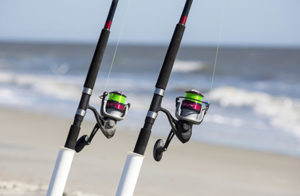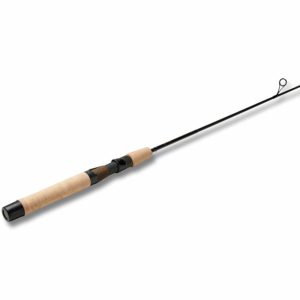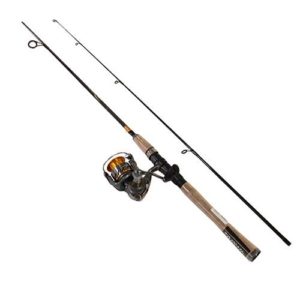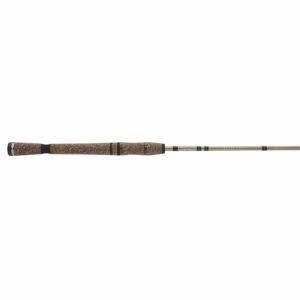 Until recently, spinning has been associated only with fishing for predators such as pike and perch. These days, however, advanced spinning equipment also allows you to use the spinning fishing technique for non-predatory fish thanks to its outstanding capabilities: roach, bream, carp, and many other species.
Until recently, spinning has been associated only with fishing for predators such as pike and perch. These days, however, advanced spinning equipment also allows you to use the spinning fishing technique for non-predatory fish thanks to its outstanding capabilities: roach, bream, carp, and many other species.
I believe that spinning is the most effective method of fishing, much more effective than the traditional baitcasting. The spinning technique is all about casting an artificial lure and pulling it in such a way as to make it appear more like a living prey to tempt the fish to bite. That’s why I said that it has been used for fishing predator fish.




But you can’t pull off that kind of technique without an especially made fishing rod and reel. Or maybe you can, but it won’t be worth it.
The critical element in spinning fishing is a suitable spinning rod that ensures full comfort of throws and energetic moves. When spinning, the angler has to change that position often. It is essential that the spinning rod is handy, light, and, at the same time, durable.
I know how hard it is to choose the appropriate spinning rod, especially if you are a beginner and don’t know anything about spinning rods. That is why I have prepared a list of 5 best fishing spinning rods that I have found. I have also made a buyer’s guide for your convenience so that you can pick up the best spinning rod for you.
Every angler has a favorite design and most interesting target of spinning fishing. In my review, I have collected fishing rods of many designs to help everyone make the right choice, depending on individual preferences.
Top 5 Best Spinning Rods for Fishing in 2019
1G.Loomis SR — Best Sports Rod
G.Loomis is of the best manufacturers in the world to buy fishing rods from. This American company chose to narrow down the assortment of products they make. Fishing rods if the only thing that they make, aside from some minor accessories. They offer the largest selection of quality fishing rods in America.
They care very much for their prestige and image, and that is an insurance of sorts for you as a buyer. The sr spinning rod is a genuinely legendary model from a legendary American manufacturer. Despite its lightweight, it can resist a massive trophy.
- High-quality design. This is a beautiful rod.
- High-reliability. Despite its lightweight, it is more than reliable.
- The comfort of use. The rod is very comfortable to hold in hand.
- High sensitivity. It is a very sensitive rod, and that makes it a great spinning rod for beginners.
- Casting range. You can cast the lure far enough.
- Overpriced. If you have a rod as good, it is bound to have some disadvantage. In this case, it is the price.
2Shimano EXAGE — Best Bang for the Buck
Shimano is a Japanese company that manufactures fishing gear of all sorts, including spinning rods. Thanks to their high quality, Shimano has been a global leader in this field for many years. This spinning rod features everything they can be proud of affordable price, reliability, high functionality, beautiful design.
This series of spinning from the first days of market appearance has been able to gather a lot of excitement around. The price to quality ratio Is nothing but attractive. Due to hyper-advanced Japanese technologies, this carbon rod maintains declared reliability.
It’s an excellent budget spinning rods, more than suitable for amateur anglers.
- High quality
- High reliability. Graphite fishing rods are generally really sturdy
- The comfort of use
- Ultra-light 30-ton carbon
- Strong ring system
- Not a very good reel seat
- Not universal
3Eagle Claw PK555SP — Cheapest Telescopic Rod
It’s a great fishing rod from Eagle Claw. Telescopic rods will suit those who prefer compact gear.
The rod has a good quality, and you can bring it with you even on a business trip or a visit only to unpack it when you finally need it.
The weight is a significant disadvantage. There is also a small loss of power, but it cannot be avoided.
The PK555SP rod is a high-quality, telescopic spinning rod that is suitable for absolutely everyone.
- High quality
- Average reliability
- Compactness. The spinning rod packs small
- Reasonable price
- Uncomfortable reel mount
- Not durable enough
4Daiwa CROSSFIRE — Best for Amateurs
Daiwa is another Japanese brand that produces a large number of rods. This rod can boast reliability and use of innovative technologies in its production. Not many other manufacturers can compete with Daiwa.
This fishing rod features perfect balance, fast action, and huge sensitivity despite that. At the same time, it has a lightweight structure that helps to achieve excellent strength.
This Daiwa spinning rod is a great option for fans of telescopic rods.
- High quality
- Excellent reliability
- Compactness
- Good sensitivity
- Strong ring system
- Quite heavy in the hand
5Fenwick Spinning — Most Reliable Spinning Rod
Fenwick is another American brand. They have the largest number of rods produced. The relatively low price, quality, and reliability describe this spinning rod well.
Rods of the same type are for their ease and good sensitivity. Also, the average price for such a spinning rod is higher than this rod costs.
All in all, you get high quality at a great price. The rod is equipped with a superfast system and is lightweight.
- High quality
- Excellent reliability
- Beautiful design
- Comfortable handle
- Versatile
- High price
Buyer’s Guide
Spinning is one of the most popular methods of catching predatory fish. Over the years, the evolution of angling techniques, fishing equipment, and knowledge made spinning fishing an extremely effective method. In my opinion, it is much more effective than the traditional baitcasting fishing, which still has a lot of support base.
When I use baitcasting, I am doomed to wait, sometimes completely pointlessly, until the fish bites. When spinning, however, the fish is not looking for the angler. It is the angler who is looking for the fish, often leading the lure precisely to the predator’s mouth. This is what puts spinning in the light of the most effective angling methods.
Continuous fly fishing makes it possible to catch a fish every once in a while. The spinning fishing method allows dragging the lure through a shoal of smaller predators willing to try their luck.
When spinning, the angler can walk around the edge of the lake or swim in the middle of the river. He can stop at a place of his choice and do a few throws or a dozen. He has the luxury of changing the area of fishing to cast the lure again. Spinning is all about continually searching for new fishing places and fish, which, after all, also like to wander around. That makes spinning fishing great for motivated people who want to get their adrenaline rush from such a seemingly relaxing activity. Those who think that fishing is boring should try spinning fishing. I’m sure you will not get bored!
Many believe that spinning is simple and does not require a lot of financial investment because one rod is enough. Indeed, you do not need other gear, such as tripods, props, lights, chairs, and other equipment so necessary in other fishing methods. Nor do you need barley, because you do not fish in one place, you are always on the move, trying different places.
So is spinning fishing really cheaper?
In part, yes, but saying that the spooning method that does not require funds is inaccurate. A good rod and reel can cost a fortune.
Basic Requirements for Universal Rods Capable of Spinning Fishing
The most frequently asked question I hear from spinning enthusiasts is what rod is best to buy. That’s not surprising. What is surprising is the question of what kind of rod would be universal enough so that it can be used for spinning fishing and baitcasting. That’s not really possible. You can find a universal rod, but it’s going to be good at one thing, and subpar doing the other. Or mediocre at best at both. Nothing could be more wrong. You can’t extend spinning techniques to non-spinning rods, and you can’t expect an excellent performance that does not involve spinning from a spinning rod.
Today, it is not enough to equip yourself with a pair of spinners of various shapes to do a quality spinning. You need a dedicated spinning rod if you want to try spinning. Sorry to disappoint you.
Types of Spinning Rods
Most spinning rods are usually two or three-part. They are often made as telescopic rods, from 6 feet to 12 feet long. They are also made for different lure weights. The choice of equipment depends on what methods and lures you will be using.
Light Rods
Ultralight rods are made for lures from 0.5 to 10g. Light rods are best for lures between 2g and 15g.
Light rods are usually designed for perch fishing using light silicone baits. Their main features are lightness, sensitivity, and the distance of casting the bait. These rods are characterized by a very sensitive tip that is good at signaling about fish biting the lure. At the same time, the rod does not give the fish any strange vibes by making the bait move unnaturally.
The maximum load of ultra-light rods is about 9 pounds.
Heavy rods
Medium rods can handle casting 10-30g lures.
Heavy rods can bear lures from 20g to 80g and heavier.
Medium and heavy rods are used to catch large predatory fish. Such rods allow the use of large rubber lures, wobblers, and large spinners. They do well during long-range fishing when you need a reserve of power to cast a massive lure. The durable construction of these rods allows you to pull a large fish.
Non-spinning specific features
Choosing a new rod sometimes causes problems, even for experienced anglers. Let’s begin at the beginning with the characteristics common to all rods, which should be noted when buying spinning rods.
Parameters
Before you buy any fishing rod, you need to pay attention to its:
- Action
- Length
- Transport length
- Weight
Action
The action is about how the rod will behave during the casting and fishing, how much it will flex, and how much it will affect the effectiveness of fishing. The action of the spinning rod consists of two factors: the speed of the blank and the degree of flex.
Fast action rods allow for precise casts and very fast pulls. Using them requires a lot of experience when towing fish.
Slow action rods are not as precise, but they are suitable for beginners.
Length
It’s primarily a matter of taste. However, you should know that a properly selected rod length will allow you to achieve better results at fishing. To a large extent, the length of the rod depends on the method used, the type of lure, and the place of fishing. Boat fishing works better with short rods, and if you’re casting from the shore, you may need a long rod.
Transport length
This parameter is all about traveling with your fishing rod. The smaller the rod is when folded, the easier and more convenient it is to carry.
Weight
For an angler using rod holders, stands, tripods, and so one, the difference of 4 ounces means little. However, when spinning, those modest 4 ounces can make your hand go numb after one hour. The lighter the rod, the better.
Questions and Answers
I already have that question covered it in one of my other reviews, but I’ll still answer it. Before I give you a really quick example, I’m going to say it’s not really hard to do. It’s just very tedious and tiresome, and it’s going to take a lot of your time, but otherwise, it is not complicated at all.
All you have to do is to take some marine wax, put it on your fiberglass boat by dipping the end of a towel or any piece of cloth. Rub the boat gently with that piece of fabric while working overlapping swirls. Since you’re working manually, you’re going to go slow, working a little area a time. Once you’ve done, let it haze up a little bit and come back with a terry cloth towel. Now, you have to rub the wax off, and you do that in overlapping sections all the way around your boat. Usually, one time is enough, but if your wax or polish manufacturer has a different idea, then, by all means, you can heed their recommendation. Typically if it’s not one layer that they suggest, it’s going to be two, and that’s twice as hard since you’re working your elbow rather than a power tool. One layer is often enough to offer basic protection, and it’s easier that way when you’re doing things manually.
Another choice would be abandoning the idea or working and polishing entirely — now that would really save you some time — but unfortunately, a boat that sails unprotected from the UV and salt water can deteriorate surprisingly fast. If doing everything manually is too hard for you, you definitely want a power buffer.
I’m not saying that you shouldn’t sand and wax by hand, you will actually need to do that at least once, but only to get the feel of your boat, how it feels to work it. After you do that, working the power buffer is going to be a lot easier than if you’re going in blind.
